ISSN ONLINE(2278-8875) PRINT (2320-3765)
ISSN ONLINE(2278-8875) PRINT (2320-3765)
Prof. Milind S. Narlawar1, Dr. S. L. Badjate2
|
| Related article at Pubmed, Scholar Google |
Visit for more related articles at International Journal of Advanced Research in Electrical, Electronics and Instrumentation Engineering
This paper presents a novel single port swastika shaped dotted monopole antenna evolved from a simple circular monopole antenna by introducing swastika shaped slots and the dots in the patch geometry. This antenna behaves as an ultra wideband sensing antenna which works in the frequency range of 3.6GHz to 8.9GHz .This antenna is further modified by connecting stubs with the switches. By appropriate combination of switches the antenna works as a reconfigurable antenna. The proposed antenna suitable for cognitive radio applications was designed and analysed by using software HFSS 13.0 which is based on finite element modelling (FEM). Antenna performance parameters such as antenna gain, return loss, VSWR over the operating bands have been observed and found to be well within the expected range.
Keywords |
| cognitive radio, ultra wideband, sensing antenna, reconfigurable antenna |
INTRODUCTION |
| The rapid growth of communication systems and the increase demand for frequency bands have caused a shortage in the available RF spectrum. Current spectrum allocations are highly underutilized where it is found that the spectrum can be idle for 90% of the time [12]. Cognitive radio system based on software defined architecture aims to improve the spectrum utilization by changing the transmitter parameters based on the interaction with the environment in which it operates [12]. |
| The monitoring of the wireless spectrum is the key in cognitive radio since the spectrum can be idle for most of the time. The aim of such a system is to improve the spectral utilization by dynamically interacting with the RF environment. A cognitive radio is an intelligent communication system that is able to learn from the environment and adapt to the variations in its surrounding by adjusting the transmit power, carrier frequency, modulation strategy or transmission data rate. Therefore, the main objective of a cognitive radio system is to ensure highly reliable communication whenever and wherever needed [7].For cognitive radio application, both, a UWB antenna for channel sensing and a reconfigurable antenna for communication are required [7]. We discuss how to implement an antenna system for the spectrum "underlay" cognitive radio. For this case, primary and secondary users can transmit simultaneously. Secondary users should transmit below a specific interference margin. This is achieved via a UWB antenna that has the capability to tune its notch frequency to minimize interference between primary and secondary users. |
| In frequency reconfigurable antenna operating frequency can be varied electronically. Excellent individual radio performance, suffers from problems lack of space assigned for antennas. The strong coupling between radios. However, multiband antennas face serious challenges as more and more wireless services are packed into ever smaller devices. It is particularly difficult to obtain satisfactory bandwidth and radiation efficiency in each supported band. Also, a multiband antenna requires stringent filters to suppress all received signals except desired one in a given moment of a time. It essentially occupies same space as the antenna dedicated for a single band. However, instantaneous band of this antenna can be reconfigured and thus it is able to effectively cover several bands. Also, reconfigurable antenna is usually well matched only for desired band and therefore has inherent filtering behavior. |
| Solution to this problem is a reconfigurable antenna that can be dynamically tuned to different narrow channels of service. Because of narrower bandwidth, efficiency is expected to be higher. At the same time, antenna possesses filtering characteristics and contributes to a noise and interference suppression. |
| Two designs of an ultra-wideband antenna with reconfigurable band notches are presented. The first design is based on several nested complementary split ring resonators, whereas the second has two identical split-ring resonators. Electronic switches mounted across or along these resonators serve to activate or deactivate their corresponding band notches, thus leading to band-notch reconfigurability. [13] |
| The communicating antenna is a 40mm-long 1mm-wide microstrip line connected to a 50-Ω feed line via a matching section. This structure yields multiple resonances in the 3.1−10.6 GHz UWB frequency range. Two 1×1 mm2 electronic switches are incorporated along the antenna for use in a frequency reconfigurability scheme. By controlling these switches, the length of the antenna is changed, thus leading to various resonance frequencies. Additional switches can be used to obtain more resonances. |
II. OBJECTIVE |
| The objective is to design an antenna for cognitive radio applications which should be ultra wide band and omnidirectional and to evaluate the performance of an antenna. Several factors need to be considered while designing the antenna, including bandwidth, polarization, radiation pattern and return loss. The antenna performance parameter are expected to have the values in following range |
| ïÃâ÷ 50Ω input impedance |
| ïÃâ÷ VSWR between 1 and 2. |
| ïÃâ÷ Return loss -10db in the desired range. |
| ïÃâ÷ Sensing antenna should be Wideband antenna with Omni directional radiation pattern. |
| ïÃâ÷ Communicating antenna should be reconfigurable for narrow bandwidth and directional radiation pattern. |
III. GEOMETRY OF AN ANTENNA AND SIMULATION RESULTS |
A. Sensing Antenna |
| The proposed UWB monopole antenna is shown in Fig.1. The circular monopole antenna with radius 12 mm, a 50 Ω microstrip feed line are printed on one side of the FR4 substrate. The length and the width of the dielectric substrate are 60x50mm. The width of the microstrip feed line is fixed at 2.6mm to achieve 50Ω. The Swastika shaped monopole antenna is evolved from the simple circular monopole first by incorporating swastika shaped slots in in the circular patch which improves the bandwidth substantially as compared to the simple monopole and then the circular dot shaped slots are inserted in the swastika shaped monopole which still increases the band width.The geometry is further modified by the four stubs through the switches as shown. |
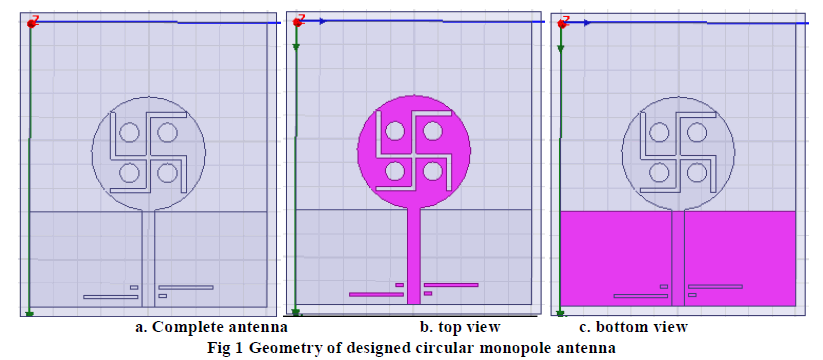 |
| The proposed antenna has been simulated in HFSS 13.0 software. The simulated antenna parameters viz. input impedance, return loss and radiation pattern are shown. Fig.2 shows the return loss plot for the circular monopole antenna. Fig3. shows the vswr plot. Fig.4. shows the impedance plot of circular monopole. Fig.5 and fig 6. shows the 3D and 2D radiation pattern of antenna. |
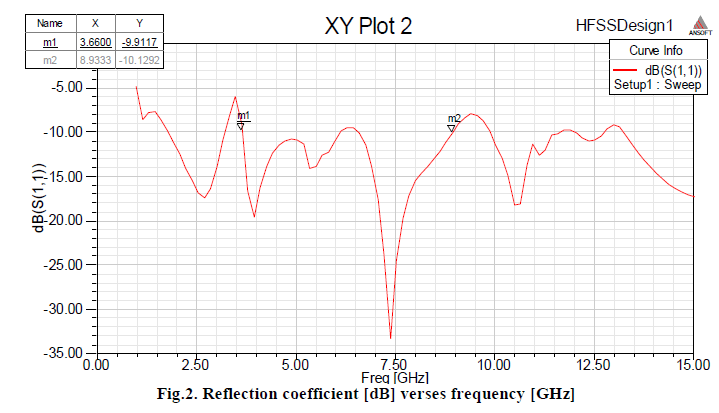 |
| An antenna behaves as an ultra wideband sensing antenna which works in the frequency range of 3.6GHz to 8.9GHz. Thus the antenna shows a wide bandwidth of about 5.3GHz .The impedance bandwidth is calculated by considering the range of frequencies below -10dB.The maximum return loss for the antenna is found to be -33dB at 7.3 GHz. |
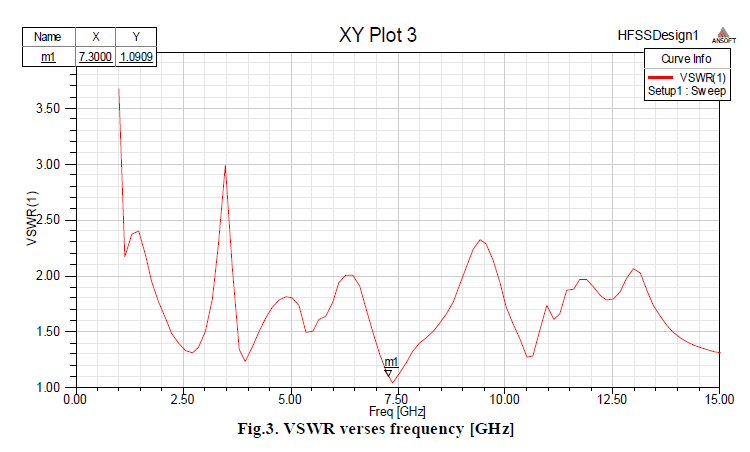 |
| The VSWR plot shows the impedance bandwidth from 3.6GHz to 8.9GHz and the lowest value of VSWR is found to be 1.09 at the frequency of 7.3GHz . The impedance bandwidth is calculated by considering VSWR in between 1 to 2. |
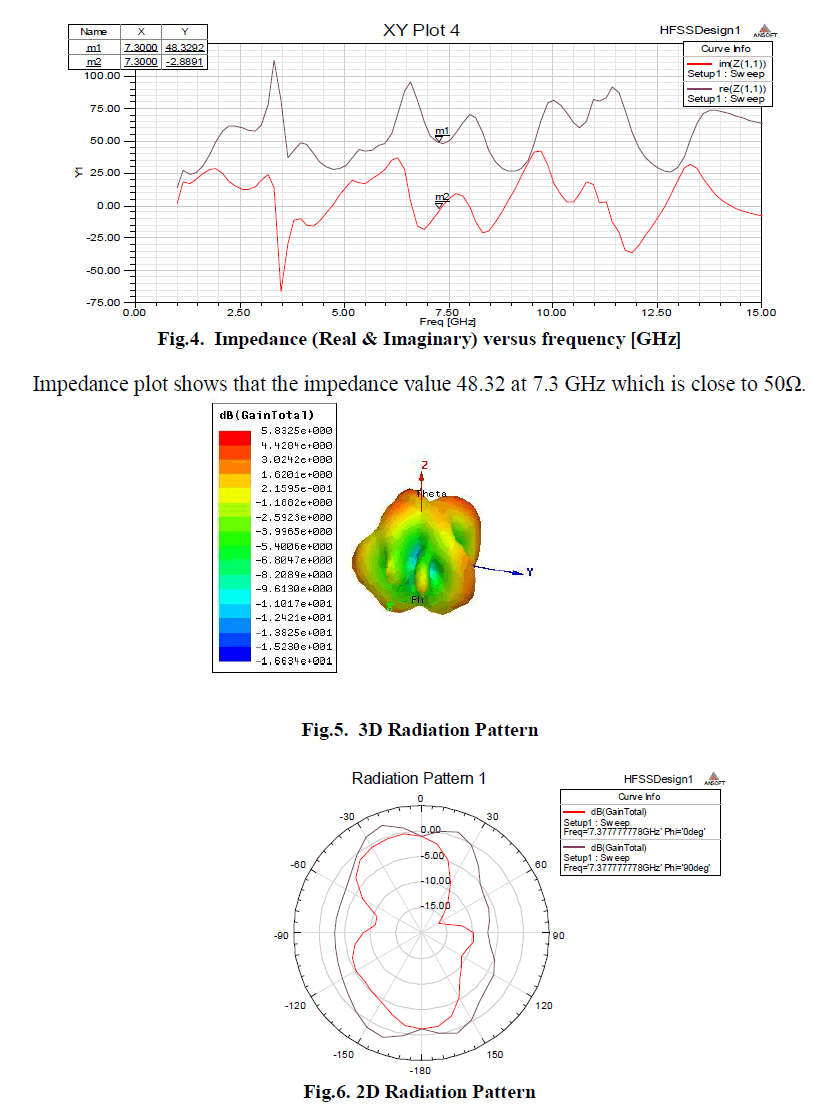 |
| The gain of the antenna is found to be 5.83dB and the 3D radiation pattern shows almost Omni-directional radiation pattern and 2D radiation pattern shows a pattern of eight in E plane while it shows almost circular pattern in H plane. |
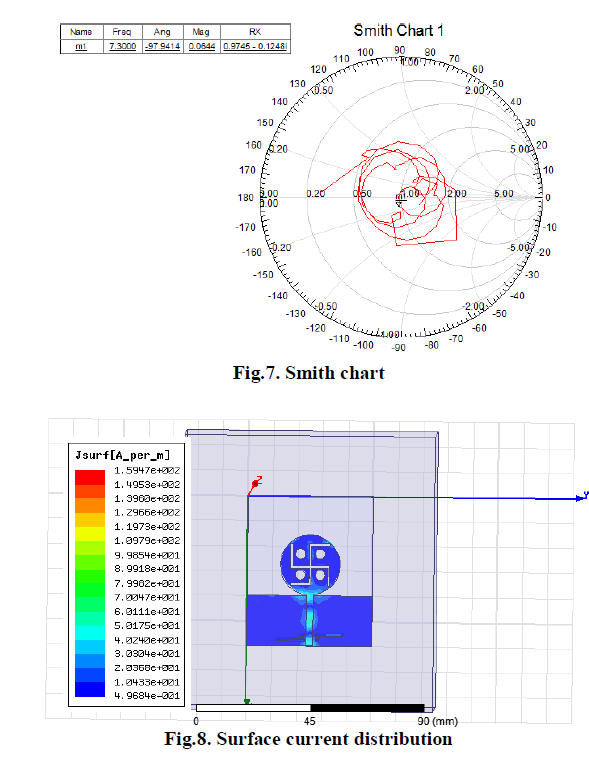 |
B. Reconfigurable Antenna |
| When switches are connected then antenna behaves as narrowband antenna with directional radiation pattern. |
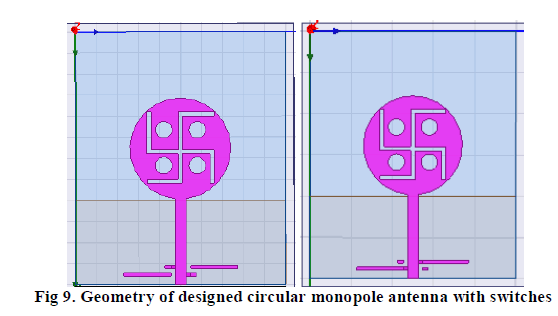 |
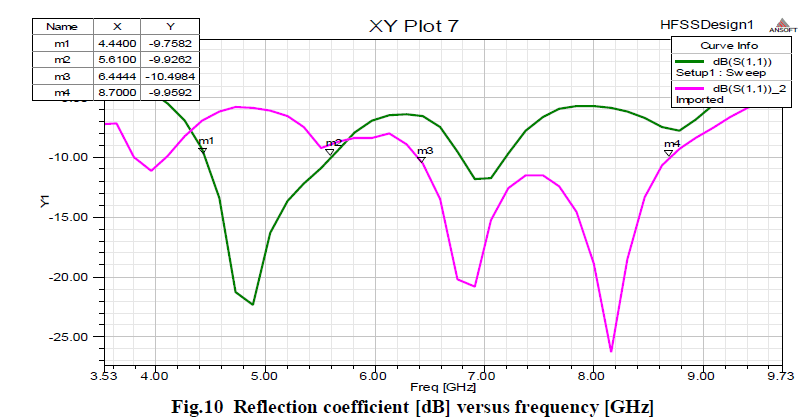 |
| The return loss plot of the rectangular microstrip antenna shows a reconfigurable antenna which operates in two bands 4.4 GHz to 5.61 GHz and 6.44 GHz to 8.7 GHz . |
 |
IV. CONCLUSION AND FUTURE SCOPE |
| The antenna is simulated using the simulation tool HFSS 13.0. The antenna can be used in a cognitive radio application for sensing and communicating purposes. The reconfigurable functions are obtained using only four switches. By switching ON and OFF status of the switch, antenna can work in two cases for underlay mode applications. The proposed antenna can also be used as multiband or multimode antennas. As a result, they can well meet the WB cognitive radio communication requirement and effectively change the modes to prevent potential interference between secondary users and primary users. |
| In the future, we will investigate the real switches, such as PIN diodes or switch circuit networks. |
References |
|